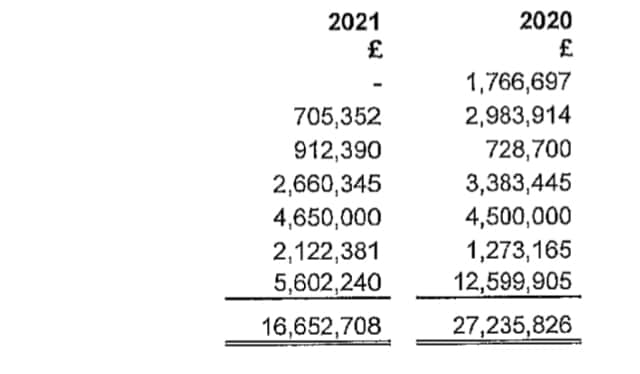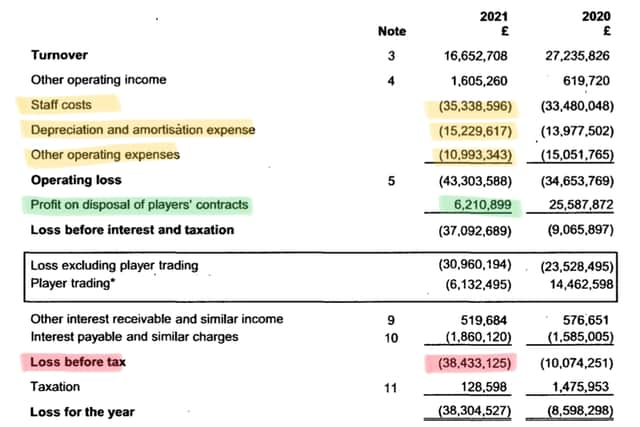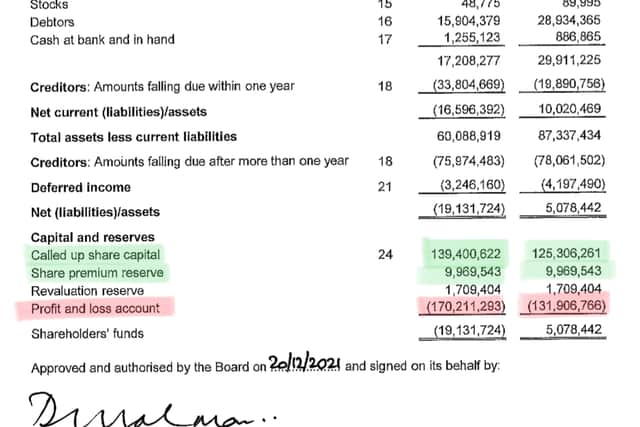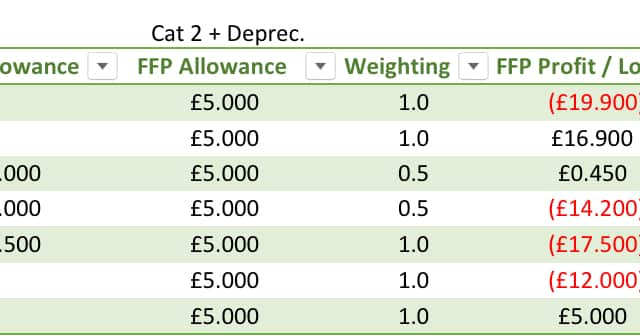How Profitability & Sustainability rules are about to impact Bristol City and other Championship clubs
and live on Freeview channel 276
There is great discussion and debate in football circles surrounding the much used three letter acronym FFP, especially in the Championship and particularly Bristol City.
You don’t need to be an accountant to understand it, I’m not, but a little bit of reading and research will help fans understand why that perennial search for a £10m / 20-goal striker is a supporter’s must-have, but not necessarily the priority for Nigel Pearson and the Board.
What is FFP?
Advertisement
Hide AdAdvertisement
Hide AdIt stands for Financial Fair Play, the brainchild of UEFA to prevent clubs spending more than they earn in pursuit of success.
FFP is mainly focussed on the levels of losses a club are allowed to make in each period, usually three years. There are other restrictions too as well as certain allowances, more on these later. You might hear the term “add-backs” especially when referring to Covid.
FFP became embedded into our domestic game to ensure clubs didn’t get into financial difficulty. The Premier League version of FFP, is closely aligned to UEFA’s rules but the limits are larger.
In the Championship, FFP is called Profitability and Sustainability (P&S), in League One and Two it is called Salary Cost Management Protocol (SCMP), and both operate under different limits and scope.
Profitability and Sustainability
Advertisement
Hide AdAdvertisement
Hide AdAt its simplest level, Championship clubs can make losses of up to £39m in a three year cycle (average £13m per annum) as long as the owner guarantees to cover these losses by injecting equity into the club (not loans).
If they don’t then the losses allowed are much lower, down to £15m (£5m per annum).
Losses are closely aligned to each club’s financial accounts submitted annually to Companies House.


For P&S specifically, each club also submits a return to the EFL where they are allowed to exclude certain costs, e.g., depreciation of assets such as the ground, Academy and Women’s team costs, etc.
Advertisement
Hide AdAdvertisement
Hide AdTherefore a £13m loss in the published accounts may end up being less for P&S purposes. In Bristol City’s case they can offset circa £5m of costs each year from the total loss because of the decreasing value of Ashton Gate Stadium and the costs of running the Academy and Women’s team.
Is P&S fair?
It ought to be, each club plays by the same rules…don’t they? Yes and no!
Clubs relegated from the Premier League have a huge advantage in that their income levels are supplemented by Parachute Payments (PPs) for up to three years post relegation, meaning that they can absorb higher costs, e.g., retain players on Premier League wages whilst attempting to get promoted back to the top-flight.
Huddersfield Town for example received £15m in PPs this season, having already received £45m and £35m in the two previous seasons. That hardly feels like a level playing field, does it?
What is profit or loss?
Advertisement
Hide AdAdvertisement
Hide AdAt its simplest, it is income (revenue) minus costs. If your costs are higher than your income, then you make a loss. Steve Lansdown currently covers the losses Bristol City make, only once in recent times has City made a profit.
What are Bristol City’s income figures?
Looking at the recently published accounts, we can see that Bristol City Holdings Limited had income of over £16m, compared to £27m the year before. The big decrease was primarily a result of Covid.


What are Bristol City’s costs?
Costs fall into three broad areas, wages, amortisation and other costs.
We can see these three cost types highlighted in yellow (below). The total costs (over £60m) are offset by money brought in from transfers (green highlight), although of course you can lose money on players too. Nor are funds from transfers guaranteed.


Advertisement
Hide AdAdvertisement
Hide AdWe arrive at a loss before tax of £38.4m for the last year (red highlight), the worst in the club’s history.
Of course, Covid has played a part both in terms of income lost because of no fans at Ashton Gate in season 2020/21, but also through a depressed transfer market too.
It is this lost transfer revenue that chief executive officer Richard Gould is lobbying the EFL and other Championship clubs to grant extra allowances for.
Other clubs have filed their annual accounts with notes to show how much they believe has either been wiped off the value of their players or how much they’ve lost in transfer income.
Special Allowances for Covid
Advertisement
Hide AdAdvertisement
Hide AdThe EFL have introduced a couple of measures to help clubs with their P&S submissions. Recognising the last third of the 2019/20 season and the whole of 2020/21 were impacted, they allowed clubs to take both years losses in total and halve them. In effect this changes a three-year P&S cycle to a four-year cycle.
I think the EFL had an expectation that clubs would start to address their lost revenues last season by cutting costs, i.e., start preparing for a bleaker post-Covid financial world. I’m not sure that happened judging by recently published accounts from some Championship clubs.
They also allowed clubs to reduce losses by the amount of lost revenue directly attributed to Covid.
There is a lack of clarity whether the recently announced allowances of £5m for each of 2019/20 and 2020/21 and £2.5m for this season are maximum allowances as they seem to be out of sync with their previously announced rules that said all lost income.
Advertisement
Hide AdAdvertisement
Hide AdWe will need to see how this plays out. But as per above some clubs are already including “add-backs” in their accounts. Stoke are claiming £30m in lost player values, whilst Nottingham Forest are projecting £12m in lost transfer profit this season.
Losses v Debt
One of the more confusing areas in P&S is related to the annual losses compared to debt.
You can see this breakdown in the club’s balance sheet (below) and perhaps the last signature from the outgoing director Doug Harman.


We see the profit and loss account (red highlight) grew by £38m from almost £132m to £170m, and we can also see how Steve Lansdown has converted almost £150m of that into equity (shares) over the years. It is easy to quickly look at the balance sheet and mistake it for the current year’s profit or loss.
What is amortisation?
Advertisement
Hide AdAdvertisement
Hide AdIt is much the same as depreciation, but instead of relating to buildings (stadium) or computer equipment which decrease in value over time, amortisation relates to player valuations, and in particular their transfer fees.
In essence a player’s value in accounting terms decreases over the length of their contact until it is zero at the end.
It is this accounting rule that Derby County owner Mel Morris tried to find a workaround for, that was rejected by The EFL and led to the 9-point deduction. Morris used a different method so that the amortisation costs could be falsely understated.
If we take Tomas Kalas, who City signed for £8m from Chelsea on a four-year contract, his value decreases by £2m per annum - £8m divided equally over four years. That £2m is a cost and affects City’s profit / losses.
Advertisement
Hide AdAdvertisement
Hide AdThis summer, as Tomas reaches the end of his third year, his value will have decreased by £6m to £2m. This is important, as should the club decide to sell him this summer, the original £8m no longer carries much (any) relevance.


Transfer profit will be determined on whether the club can sell him for more than £2m, not £8m. Should the club sell him for £5m the club would make £3m transfer profit on him. In my opinion, the days of talking about net spend aren’t really that important. As it stands Tomas costs City £2m per annum plus his wages still need to be added on top.
On the flip side, should City reach an agreement to extend Tomas’s contract this summer, then the £2m would get divided equally over the new term. If that contract was until 2026, that would be £2m divided by four years, and his value would now reduce by only £500k each season for the remainder of his time here. That would mean City would benefit by £1.5m next season (expected cost £2m, new cost £500k).
Hence there are advantages to extending the contracts of players who you originally paid large transfer fees for. Letting a record signing (at the time) like Famara Diedhiou leave for nothing last summer is effectively a loss of £5.3m plus his wages over his four years in ‘Knowle’. Many fans will argue the club didn’t get value on the pitch in his last six months here.
Advertisement
Hide AdAdvertisement
Hide AdA key point to make is that players who have come through City’s academy system, have £0 amortisation as there is no transfer fee paid. You can see why the likes of Alex Scott and Antoine Semenyo are so important to City.
Beyond Bristol City
Has P&S (or SCMP) been a success? It depends how you define success. Bury going bust and losing their place in the EFL doesn’t feel like a success. But penalising clubs who have broken the rules seems fair game.
In recent years Birmingham City (nine-point deduction), Sheffield Wednesday (12-point and relegation), Reading (six-point deduction) and Derby County (nine-points plus another 12 points for entering administration) have all been penalised.
Derby’s current situation could see the club liquidated and expelled from the EFL. Last week’s updates look as though they will get to play out this season whilst they try to secure a preferred bidder for their longer-term future.


Advertisement
Hide AdAdvertisement
Hide AdWe are starting to see other clubs submit their annual accounts for last season and there looks to be three groups emerging:
- The Parachute Payment clubs – buoyed by additional income each season, they are fine from a P&S perspective
- The Cost Control clubs – the likes of Luton, Coventry, Millwall, etc, who don’t pay large wages and fees and keep costs under control. They too are at little risk of breaching P&S.
-The Rest – a mixed bag of clubs in P&S trouble e.g., Derby, the ex-Parachute Payment clubs who’ve not adjusted to life in the Championship, e.g., Stoke and clubs like City and Blackburn who are trying to reduce their costs quickly to stay inside P&S. For several of these clubs, this years and next year’s accounts will be very interesting and may see more clubs suffering points penalties.
What next for City?
Advertisement
Hide AdAdvertisement
Hide AdI’m not an accountant, but I’ve estimated City’s P&S position for each of last season, this season and next season’s cycles. They are based on various scenarios, but do not include any transfer profit, so maybe on the pessimistic side. They do include both FFP and Covid allowances though.


What we see is that the four-year cycle from 2017/18 to 2020/21 (yellow shading) is within the £39m P&S limit, courtesy of the profit made in 2018/19 when the club sold Flint, Bryan and Reid in the summer 2018 and Kelly early in May 2019.
That profit is used again to good effect in the four-year cycle from 2018/19 to this season (2021/22), and the club is still within the P&S limit (grey shading). We won’t know if my estimates are close until the end of the year when this season’s annual accounts are signed off and published for us to view.
However, when 2018/19’s profit is no longer within the cycle, 2019/20 to next season (2022/23), then we look as if the club will break the £39m limit. However, the end of this cycle is still 15 months away so time to remedy, either by reducing costs, e.g., wages and amortisation or selling the family silver?
Advertisement
Hide AdAdvertisement
Hide AdThis is why I think Richard Gould is trying to get support for further allowances.
To some extent City did a fair chunk of ‘heavy lifting’ last summer, letting several players leave as they were out of contract, thus saving ongoing costs of wages and lowering the annual amortisation commitment.


Couple that with Baker and Weimann agreeing new contracts on publicised lower wages and my estimates come in at around £12m saved already. No mean feat, and something Nigel Pearson and Richard Gould deserve credit for.
There are also several players out of contract this summer, some with club options to extend, but much will depend on other factors.
Advertisement
Hide AdAdvertisement
Hide AdSemenyo, Scott and Massengo may influence the scope for new signings or even the contracts of players like Kalas and Bentley, and our position to recruit may change daily. I’ll be adjusting my estimates as things change.
Conclusion
P&S is well intentioned, but it has flaws. Parachute Payments is one big elephant in the room and needs to be revisited against club owners’ inability to invest if they want to, rather than just cover losses.
Why should Steve Lansdown be unable to invest an amount akin to a Parachute Payment, should he wish too?
I would like to see some form of salary cap introduced. League One and Two briefly introduced one during 2019/20 but it had some issues and needed a re-think. Hopefully the learnings from that short period can be used to implement a better alternative.
Advertisement
Hide AdAdvertisement
Hide AdFor Bristol City, its more austerity I’m afraid, unless the club sells big.
John Lansdown admitted they paid higher wages than a club of our stature should have, and the club are paying for it in the current financial climate. The other hope is that a previously negotiated sell-on from Adam Webster, Lloyd Kelly or Josh Brownhill materialises. That would be a huge boost. Fingers crossed.
Comment Guidelines
National World encourages reader discussion on our stories. User feedback, insights and back-and-forth exchanges add a rich layer of context to reporting. Please review our Community Guidelines before commenting.
